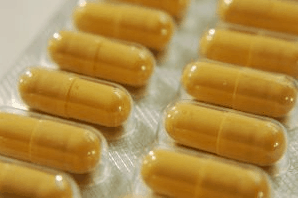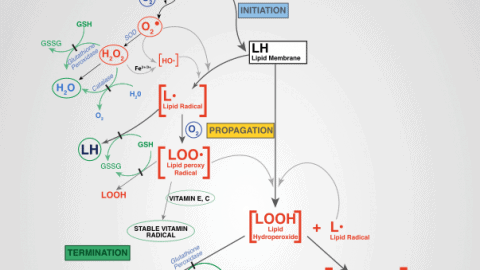Longevity scientist David Sinclair referred to DNP as “…a perfect weight loss pill” on the Joe Rogan show recently, which I discuss in my vid here. 2,4-dinitrophenol (DNP) is an old chemical with a long history, used in explosives since WWI. In the 1930’s it had a short-lived use as a weight loss drug, and was banned. A generally well written and researched summary aticle on DNP can be found via Jessica Wapner published in the Daily Beast of all places. The article also mentions how Dan Duchaine resurrected it in the public sphere to the bodybuilding/fitness community in the 90’s. Unfortunately, DNP continues to survive via the ‘net. As I knew Dan well, and he’d told me about his interests in DNP at the time, I was on the ground floor of the emergence of DNP. Here’s my summary:
Everything negative you have heard about DNP is true. Everything positive you have heard about DNP is true.
How is that possible?
DNP is the poster child for the expression used in medical/science circles “the dose makes the poison.”
More succinct, known as the three D’s: Drug, Dose, Duration.
What Is DNP? As it’s easy to Google up the basics of DNP as it pertains to weight loss, mechanisms, etc, a short summery:
“2-4-Dinitrophenol (DNP) was one of the first antiobesity therapy used in the 1930s. Its effect was first noticed among factory workers who were exposed to this and lost weight. It was shown to cause weight loss by uncoupling oxidative phosphorylation, leading to a heightened metabolic rate and increased fat metabolism. The rapid consumption of calories was thought to occur because of the shift in the proton electrochemical gradient, which results in potential energy dissipating as heat, instead of being converted to ATP. This mechanism of action also leads to an accumulation of pyruvate and lactic acids. Unlike thyroid hormone, which was used for weight loss, it did not impact on nitrogen excretion and thus was postulated to cause fat rather than lean muscle mass loss…” – https://www.sciencedirect.com/topics/neuroscience/2-4-dinitrophenol
While DNP has been given a bad rap as a toxic drug, studies suggest it has potential medical benefits, and increases the longevity of animals and indicators or metabolic health at low doses. (1,2,3,4). Again, the dose makes the poison. This is actually a common phenomena with many compounds, at one dose/schedule it’s a benefit, at another, it’s toxic. For example, the cancer drug Dasatinib is a Senolytic Drug that is highly toxic at one dose/schedule, has shown great promise as drug for anti-aging and disease prevention by removing “Zombie cells.” Zombie cells are senescent cells that survive by evading apoptotic mechanisms the body normally uses to eliminate them and they accumulate as we age.
Another is the Rapamycin, used to prevent organ rejection and suppresses the immune system and highly toxic at one dose/schedule, extends lifespan and improves metabolic health at a lower dose/schedule.
Both those drugs, Dasatinib and Rapamycin are receiving a great deal of interest and focus among researchers for their potential medical/anti-aging uses, are dangerous and toxic if not used under strict medical supervision, which brings us back to DNP…
Is DNP a viable fat loss drug under proper supervision? Yes it is. Does it have potential anti-aging/medical benefits? Yes again. Does it require more research as to how the Three D’s apply to humans? VERY much so. As always, there’s a risk to benefit issue that must be considered, and as obesity, and diseases related to it, such as heart disease, diabetes, and others are the top causes of premature death, simply ignoring DNP, leaving it to be sold via the net, is illogical and poor science. Sadly, even among some with the education to know better, understanding the concepts of the risk/benefit (vs “bad” or “good” dichotomy) and the Three D’s, is often lost on people.
The Real Problem With DNP
The real issue with DNP is that the therapeutic dose and the toxic dose/LD50* is close enough that even minor mistakes in dosing can be dangerous, and in rare cases, fatal, and that’s no BS. While I’m in favor of pursuing DNP as a viable weight loss drug and or its other potential benefits that deserves more research and interest by the medical/science community, self-administration of DNP via ‘net based sources is a VERY bad idea. Under no circumstances would I ever recommend the use of DNP, unless under medical supervision using a known source. I don’t know how to make that any clearer to readers. Unfortunately, taking the “more is better” approach so common among people looking to lose some fat or gain some muscle, will not end well as it applies to DNP.
Back In The Day
In the 90’s, I knew some physique athletes that were using DNP. What was interesting was how they almost universally reported how truly terrible they felt, like they had the flu and a fever. That’s not far off as DNP does raise body temp (to the point it can kill you…) and metabolic rate, and so not surprising at all they reported feeling terrible. But bodybuilders especially, but other athletes too, often conflate feeling terrible and suffering as it must be working and par for the course with achieving their goals and what all the “hard core” types do to succeed. It disappeared off my radar until recently when articles started popping up about its use a diet drug (see article linked in the intro) in the general population and I started receiving emails with “What do you know about this ‘new’ diet drug DNP Will?” type Qs. That prompted me to write an article and set the record straight on the topic of DNP.
Conclusion
While the science suggests DNP may be an effective and viable fat loss drug, that may also have other possible benefits, the narrow margins of safety/benefit ratio – due to the fact the therapeutic dose so close to the dose that can send people to the ER or worse – means it’s:
- A very bad idea to self-administer using questionable sources
- It needs more research in humans
- Must be administered under medical supervision for an acceptable risk/benefit
- Typical doses for weight loss was up to 300mg per day.
But did the world forget about DNP? Nope, “For the first time in 80’s years, the FDA has granted (to Mitochon Pharmaceutical, Inc., Blue Bell, PA, USA) an open Investigational New Drug (IND) approval to begin rigorous clinical testing of DNP for safety and tolerability, including for the first ever, pharmacokinetic profiling in humans. Successful completion of Phase I clinical trial will open the door to explore the merits of DNP as a possible treatment of people with many truly unmet medical needs…”(4). It’s essential to note that the doses for it’s possible medical or longevity benefits are likley to be considerably lower than what has been used for weight loss, which will greatly improve the safety profile. The human equivalent dose (HED) used that extended the life span in animals models was approximately 50mg, and a micro dose study used as low as 2.5mg! Let me repeat yet again for those in the back; The Dose Makes The Poison. I don’t understand why some have so much difficulty understanding that very basic and well established concept.
Stay tuned!
Sources:
(1) Mild mitochondrial uncoupling in mice affects energy metabolism, redox balance and longevity. Aging Cell. 2008 Aug;7(4):552-60.
Abstract
Caloric restriction is the most effective non-genetic intervention to enhance lifespan known to date. A major research interest has been the development of therapeutic strategies capable of promoting the beneficial results of this dietary regimen. In this sense, we propose that compounds that decrease the efficiency of energy conversion, such as mitochondrial uncouplers, can be caloric restriction mimetics. Treatment of mice with low doses of the protonophore 2,4-dinitrophenol promotes enhanced tissue respiratory rates, improved serological glucose, triglyceride and insulin levels, decrease of reactive oxygen species levels and tissue DNA and protein oxidation, as well as reduced body weight. Importantly, 2,4-dinitrophenol-treated animals also presented enhanced longevity. Our results demonstrate that mild mitochondrial uncoupling is a highly effective in vivo antioxidant strategy, and describe the first therapeutic intervention capable of effectively reproducing the physiological, metabolic and lifespan effects of caloric restriction in healthy mammals.
(2) The Mitochondrial Uncoupling Agent 2,4-Dinitrophenol Improves Mitochondrial Function, Attenuates Oxidative Damage, and Increases White Matter Sparing in the Contused Spinal Cord. J Neurotrauma. 2004 Oct;21(10):1396-404
Abstract
The purpose of this study was to investigate the potential neuroprotective efficacy of the mitochondrial uncoupler 2,4-dinitrophenol (DNP) in rats following a mild to moderate spinal cord contusion injury. Animals received intraperitoneal injections of vehicle (DMSO) or 5 mg/mL of DNP prior to injury. Twenty-four hours following surgery, mitochondrial function was assessed in mitochondria isolated from spinal cord synaptosomes. In addition, synaptosomes were used to measure indicators of reactive oxygen species formation, lipid peroxidation, and protein oxidation. Relative to vehicle treated animals, pretreatment with DNP maintained mitochondrial bioenergetics and significantly decreased reactive oxygen species levels, lipid peroxidation, and protein carbonyl content following spinal cord injury. Furthermore, pretreatment with DNP significantly increased the amount of remaining white matter at the injury epicenter 6 weeks after injury. These results indicate that treatment with mitochondrial uncoupling agents may provide a novel approach for the treatment of secondary injury following spinal cord contusion.
(3) 2,4 Dinitrophenol as Medicine
Cells. 2019 Mar 23;8(3):280.
Abstract
In the sanctity of pure drug discovery, objective reasoning can become clouded when pursuing ideas that appear unorthodox, but are spot on physiologically. To put this into historical perspective, it was an unorthodox idea in the 1950’s to suggest that warfarin, a rat poison, could be repositioned into a breakthrough drug in humans to protect against strokes as a blood thinner. Yet it was approved in 1954 as Coumadin® and has been prescribed to billions of patients as a standard of care. Similarly, no one can forget the horrific effects of thalidomide, prescribed or available without a prescription, as both a sleeping pill and “morning sickness” anti-nausea medication targeting pregnant women in the 1950’s. The “thalidomide babies” became the case-in-point for the need of strict guidelines by the U.S. Food & Drug Administration (FDA) or full multi-species teratogenicity testing before drug approval. More recently it was found that thalidomide is useful in graft versus host disease, leprosy and resistant tuberculosis treatment, and as an anti-angiogenesis agent as a breakthrough drug for multiple myeloma (except for pregnant female patients). Decades of diabetes drug discovery research has historically focused on every possible angle, except, the energy-out side of the equation, namely, raising mitochondrial energy expenditure with chemical uncouplers. The idea of “social responsibility” allowed energy-in agents to be explored and the portfolio is robust with medicines of insulin sensitizers, insulin analogues, secretagogues, SGLT2 inhibitors, etc., but not energy-out medicines. The primary reason? It appeared unorthodox, to return to exploring a drug platform used in the 1930s in over 100,000 obese patients used for weight loss. This is over 80-years ago and prior to Dr Peter Mitchell explaining the mechanism of how mitochondrial uncouplers, like 2,4-dinitrophenol (DNP) even worked by three decades later in 1961. Although there is a clear application for metabolic disease, it was not until recently that this platform was explored for its merit at very low, weight-neutral doses, for treating insidious human illnesses and completely unrelated to weight reduction. It is known that mitochondrial uncouplers specifically target the entire organelle’s physiology non-genomically. It has been known for years that many neuromuscular and neurodegenerative diseases are associated with overt production of reactive oxygen species (ROSs), a rise in isoprostanes (biomarker of mitochondrial ROSs in urine or blood) and poor calcium (Ca2+) handing. It has also been known that mitochondrial uncouplers lower ROS production and Ca2+ overload. There is evidence that elevation of isoprostanes precedes disease onset, in Alzheimer’s Disease (AD). It is also curious, why so many neurodegenerative diseases of known and unknown etiology start at mid-life or later, such as Multiple Sclerosis (MS), Huntington Disease (HD), AD, Parkinson Disease, and Amyotrophic Lateral Sclerosis (ALS). Is there a relationship to a buildup of mutations that are sequestered over time due to ROSs exceeding the rate of repair? If ROS production were managed, could disease onset due to aging be delayed or prevented? Is it possible that most, if not all neurodegenerative diseases are manifested through mitochondrial dysfunction? Although DNP, a historic mitochondrial uncoupler, was used in the 1930s at high doses for obesity in well over 100,000 humans, and so far, it has never been an FDA-approved drug. This review will focus on the application of using DNP, but now, repositioned as a potential disease-modifying drug for a legion of insidious diseases at much lower and paradoxically, weight neutral doses. DNP will be addressed as a treatment for “metabesity”, an emerging term related to the global comorbidities associated with the over-nutritional phenotype; obesity, diabetes, nonalcoholic steatohepatitis (NASH), metabolic syndrome, cardiovascular disease, but including neurodegenerative disorders and accelerated aging. Some unexpected drug findings will be discussed, such as DNP’s induction of neurotrophic growth factors involved in neuronal heath, learning and cognition. For the first time in 80’s years, the FDA has granted (to Mitochon Pharmaceutical, Inc., Blue Bell, PA, USA) an open Investigational New Drug (IND) approval to begin rigorous clinical testing of DNP for safety and tolerability, including for the first ever, pharmacokinetic profiling in humans. Successful completion of Phase I clinical trial will open the door to explore the merits of DNP as a possible treatment of people with many truly unmet medical needs, including those suffering from HD, MS, PD, AD, ALS, Duchenne Muscular Dystrophy (DMD), and Traumatic Brain Injury (TBI).
(4) Additional sources HERE
*= “In toxicology, the median lethal dose, LD₅₀, LC₅₀ or LCt₅₀ is a measure of the lethal dose of a toxin, radiation, or pathogen. The value of LD₅₀ for a substance is the dose required to kill half the members of a tested population after a specified test duration.”
Will Brink is the owner of the Brinkzone Blog. Will has over 30 years experience as a respected author, columnist and consultant, to the supplement, fitness, bodybuilding, and weight loss industry and has been extensively published. Will graduated from Harvard University with a concentration in the natural sciences, and is a consultant to major supplement, dairy, and pharmaceutical companies.
His often ground breaking articles can be found in publications such as Lets Live, Muscle Media 2000, MuscleMag International, The Life Extension Magazine, Muscle n Fitness, Inside Karate, Exercise For Men Only, Body International, Power, Oxygen, Penthouse, Women’s World and The Townsend Letter For Doctors.
He’s also been published in peer reviewed journals.
Will is the author of the popular e-books, both accompanied by private members forum access , Bodybuilding Revealed & Fat Loss Revealed.
You can also buy Will’s other books on Amazon, Apple iBook, and Barnes and Noble.






